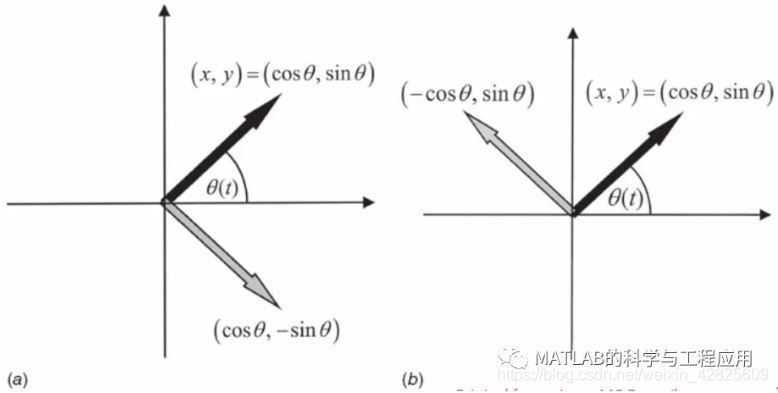【讀書2】【2014】基於MATLAB的雷達訊號處理基礎(第二版)——接收機(2)
圖1.10對該問題進行了描述。
Figure 1.10 illustrates the problem.

圖1.10 (a)圖1.9中接收機的I通道只測量相位θ(t) 的餘弦值;(b)Q通道只測量相位θ(t) 的正弦值。(a) The Ichannel of the receiver in Fig. 1.9 measures only the cosine of the phasorθ(t). (b) The Q channel measures only the sine of the phasor
考慮圖1.10a中的情況。
Consider the case shown in Fig. 1.10a.
訊號相位θ(t)表示為複平面中的實心黑色相量。
The signal phase θ(t) is represented as asolid black phasor in the complex plane.
如果接收機中只有I通道,那麼只能測量θ(t)的餘弦值。
If only the I channel is implemented in thereceiver, only the cosine of θ(t) will be measured.
這樣真實的相量就不能與圖中的灰色向量–θ(t)進行區分了。
In this case, the true phasor will beindistinguishable from the gray phasor –θ(t).
類似地,如果接收機中只有Q通道,那麼只能測量出θ(t)的正弦值,也就無法區分真實向量與灰色向量π – θ(t)。
Similarly, if only the Q channel isimplemented so that only the sine of θ(t) is measured, then the true phasorwill be indistinguishable from the gray phasor of Fig. 1.10b, which correspondsto π – θ(t).
當I和Q通道同時存在時,才能明確地確定相量所在的象限區間。
When both the I and Q channels areimplemented, the phasor quadrant is determined unambiguously.
事實上,訊號處理器通常將I訊號指定為覆信號的實部,將Q訊號指定為虛部,從而構成覆信號
In fact, the signal processor will normallyassign the I signal to be the real part of a complex signal and the Q signal tobe the imaginary part, forming a single complex signal

式(1.20)以一種更直觀的方式表明了理想的相干接收機對發射訊號的影響。
Equation (1.20) implies a more convenientway of representing the effect of an ideal coherent receiver on a transmittedsignal.
通常將發射訊號的正弦波形式替換為等效的復指數形式。
Instead of representing the transmittedsignal by a sine function, an equivalent complex exponential function is usedinstead.
那麼,式(1.17)的回波訊號可以替換為
The echo signal of (1.17) is thus replacedby

圖1.9的接收機結構則替換為圖1.11中的簡化模型,其中回波訊號通過與參考本振exp(– jΩt)進行復乘解調。
The receiver structure of Fig. 1.9 is thenreplaced with the simplified model of Fig. 1.11, where the echo is demodulatedby multiplication with a complex reference oscillator exp(– jΩt).

Figure 1.11. 使用復指數訊號的簡化接收機模型Simplified transmission and receiver model using complex exponentialsignals.
這種假設為復發射訊號和復解調器的模型能夠準確地獲得式(1.20)的結果,並明確地模擬了接收機的I、Q通道,但表達形式更加簡單、緊湊。
This technique of assuming a complextransmitted signal and corresponding complex demodulator produces exactly thesame result obtained in Eq. (1.20) by explicitly modeling the real-valuedsignals and the I and Q channels, but is much simpler and more compact.
本書以後的部分都將採用復指數的分析方法。
This complex exponential analysis approachis used throughout the remainder of the book.
重要的是要記住,這只是一種分析的方法;實際的模擬硬體設計仍然必須使用實值訊號進行處理。
It is important to remember that this is ananalysis technique; actual analog hardware must still operate with real-valuedsignals only.
然而,一旦訊號被數字化,就可以在數字處理器中被明確地視為覆信號。
However, once signals are digitized, theymay be treated explicitly as complex signals in the digital processor.
——本文譯自Mark A. Richards所著的《Fundamentals of Radar Signal Processing(Second edition)》
更多精彩文章請關注微訊號:
